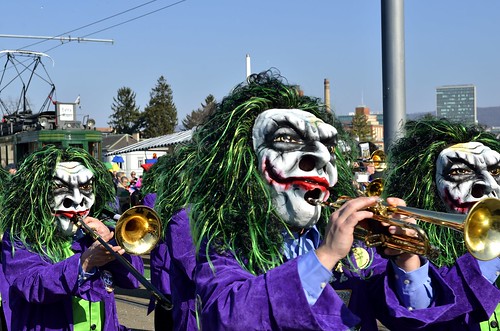Welcome to Word Buzz Wednesday, your go-to place for the most interesting words of the week. The latest: a fiery cautionary tale; a cacophonous parade; your next all-girl punk band.
Reichstag fire
“Whenever citizens and politicians feel threatened by executive overreach, the ‘Reichstag Fire’ is referenced as a cautionary tale.”
Lorraine Boissoneault, “The True Story of the Reichstag Fire and the Nazi Rise to Power,” Smithsonian.com, February 21, 2017
On February 27, 1933, says Smithsonian.com, “a sizeable portion of the parliamentary building in Berlin, the Reichstag, went up in flames from an arson attack.” Hitler blamed the attack on the Communists, proclaiming that “this murderous pest” must be crushed “with an iron fist.” On February 28, an act was drawn up that “abolished freedom of speech, assembly, privacy and the press,” and “legalized phone tapping and interception of correspondence.”
Later evidence suggested that the individual convicted for the arson, Marinus van der Lubbe, couldn’t have acted alone, and witness testimony suggested the Communists weren’t involved at all, but “the group of Nazis who investigated the fire and later discussed its causes with historians covered up Nazi involvement to evade war crimes prosecution.”
kangaroo care
“When he had to go back in to hospital with an umbilical cord infection I’d go in early every morning and last thing at night to do kangaroo care.”
Lena Corner, “Could ‘Kangaroo Care’ Change The Way We Treat Premature Babies?” Digg, February 7, 2019
Kangaroo care, says Cleveland Clinic, is “a method of holding a baby that involves skin-to-skin contact.” The baby is placed upright inside the “pouch” of parent’s shirt and against their bare chest, much like the way a mother kangaroo carries her young.
The method originated in late 1970s Bogotá, Colombia, where “the death rate for premature infants was 70 percent.” Researchers discovered the babies “who were held close to their mothers’ bodies for large portions of the day not only survived, but thrived.”
Dirty Thursday
“Lucerne’s spectacular event starts on so-called ‘Dirty Thursday’ at 5am, and there’s little let up from then on in.”
“Party like the Swiss at these eight spectacular carnivals,” The Local, February 21, 2017
Dirty Thursday, or Schmutzigen Donnerstag, refers to the Thursday before Ash Wednesday in some parts of Switzerland, and often kicks off Fasnacht, or carnival time, complete with parades of “costumed brass bands” playing “dissonant chords of marches and pop songs,” known in Swiss-German as Guggenmusik.
Baily’s beads
“Another point of interest is what’s called ‘Baily’s Beads,’ little twinkles that appear around the rim of the moon as the sun shines through craters and gets blocked by peaks.”
Charlie Wood, “Scientists need YOU to help make a solar eclipse movie,” Christian Science Monitor, February 21, 2017
Baily’s beads refer to “a row of bright spots observed” before and after a total solar eclipse, during which “the slender, unobscured crescent of the sun’s disk appears momentarily like a row of bright spots resembling a string of beads.” The term is named for English astronomer Francis Baily, who observed the phenomenon during an annular eclipse of the sun on May 15, 1836.
pink noise
“The pink noise is around 80 decibels, about equal to that of a dishwasher and completely safe.”
Philip E. Ross, “Mercedes’s Pink Noise Says: Prepare For Impact,” IEEE Spectrum, February 7, 2017
Pink noise is like white noise but lower — that is, with more low-frequency components. Mercedes-Benz is using pink noise as a precrash feature, says IEEE Spectrum. Now not only will you be protected with an automatically tightened seatbelt and airbags, your ears will be safeguarded against the deafening sounds of a crash by a burst of pink noise. That triggers the acoustic reflex, in which the stapedius muscle “contracts, bracing it, the bones of the inner ear, and the eardrum.”
